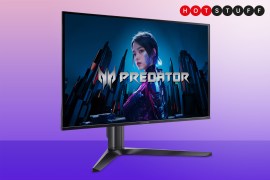LG UltraGear 32GS95UE OLED gaming monitor review: colourful, competitive
WOLED panel tech and gamer-friendly features set this screen apart

Stuff Verdict
Pro-grade refresh rates and response times meet an impactful OLED picture. The LG UltraGear 32GS95UE is a fantastic – if expensive – gaming monitor that doesn’t need gimmicks to impress.
Pros
- Gorgeous 4K display with epic contrast
- Dual mode resolution/refresh rate great for gamers
- Impressive onboard audio
Cons
- Not the last word in colour accuracy or brightness
- Connectivity a bit limited versus rivals
- The competition is slightly cheaper
Introduction
LG OLEDs pretty much rule the roost in TV land: the firm’s home-grown 4K TVs are first class, and other manufacturers are queuing up to buy its panels. That hasn’t been the case for PC monitors, with Samsung’s QD-OLED displays making a bigger splash. The LG UltraGear 32GS95UE is looking to change that. This 32in screen is the first example of LG’s WOLED panel tech on a smaller scale, and one that doesn’t skimp on gamer-friendly features.
The headline act is a dual mode resolution, which can flip between 4K/240Hz and 1080p/480Hz on the fly for the fastest response times in competitive games. FreeSync and G-Sync adaptive refresh also make the cut, along with HDMI 2.1 connectivity and some of the best built-in speakers you’ll find on any gaming monitor. A matte panel finish is something of a rarity among OLEDs of all kinds, too.
New tech rarely comes cheap, though. The 32GS95UE will set you back more than a lot of QD-OLED rivals, at $1400/£1300. Are the differences big enough to get you to open your wallet? After living with one for the past few weeks, I’m convinced PC gamers will be very satisfied.
How we test gaming hardware
All games consoles and gaming hardware tested on Stuff are put through their paces with days’ worth of play time. We use our years of testing experience to judge areas such as build quality, software experience, battery life and other features. Manufacturers have no visibility on reviews before they appear online, and we never accept payment to feature products.
Find out more about how we test and rate products.
Design & build: hex appeal
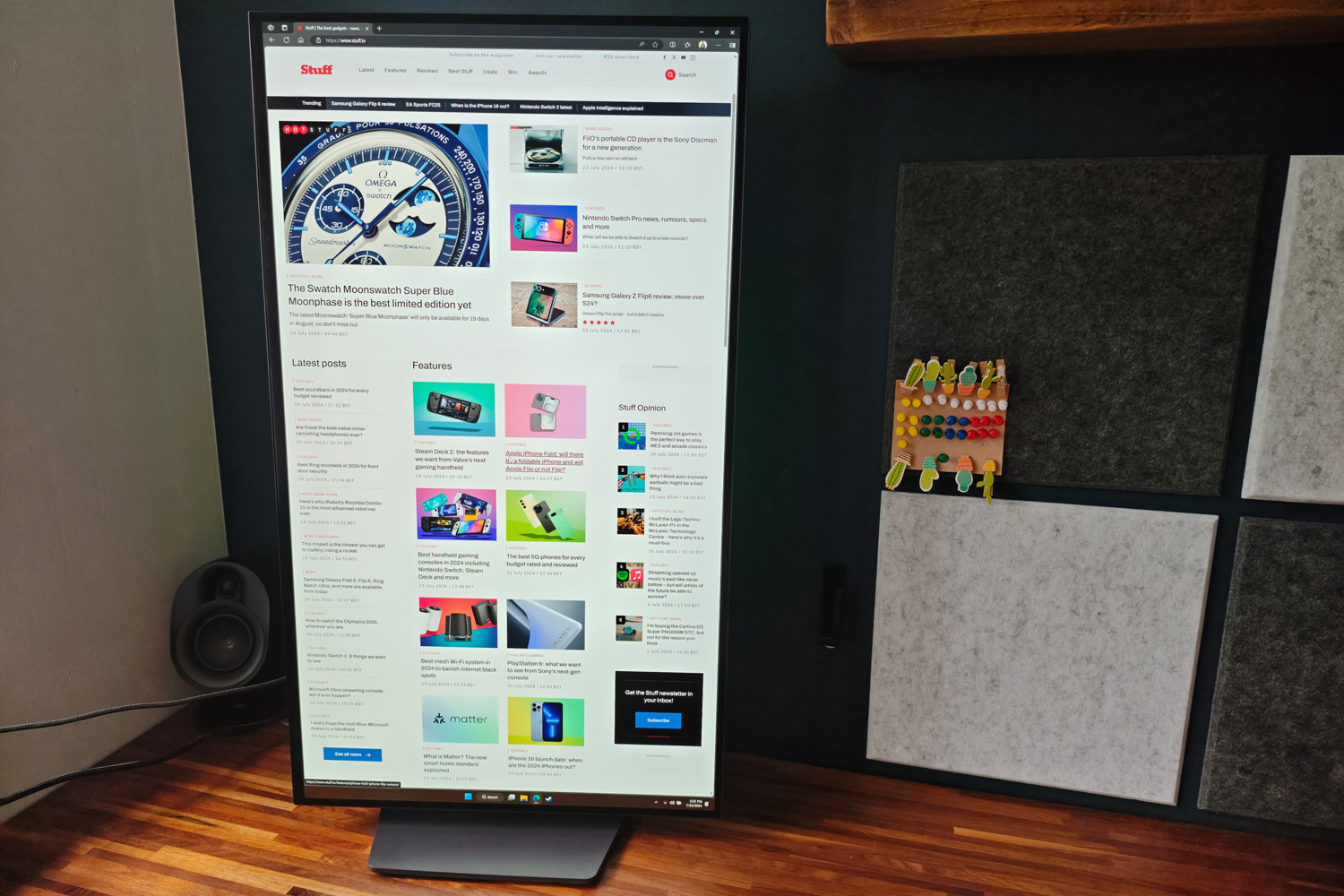
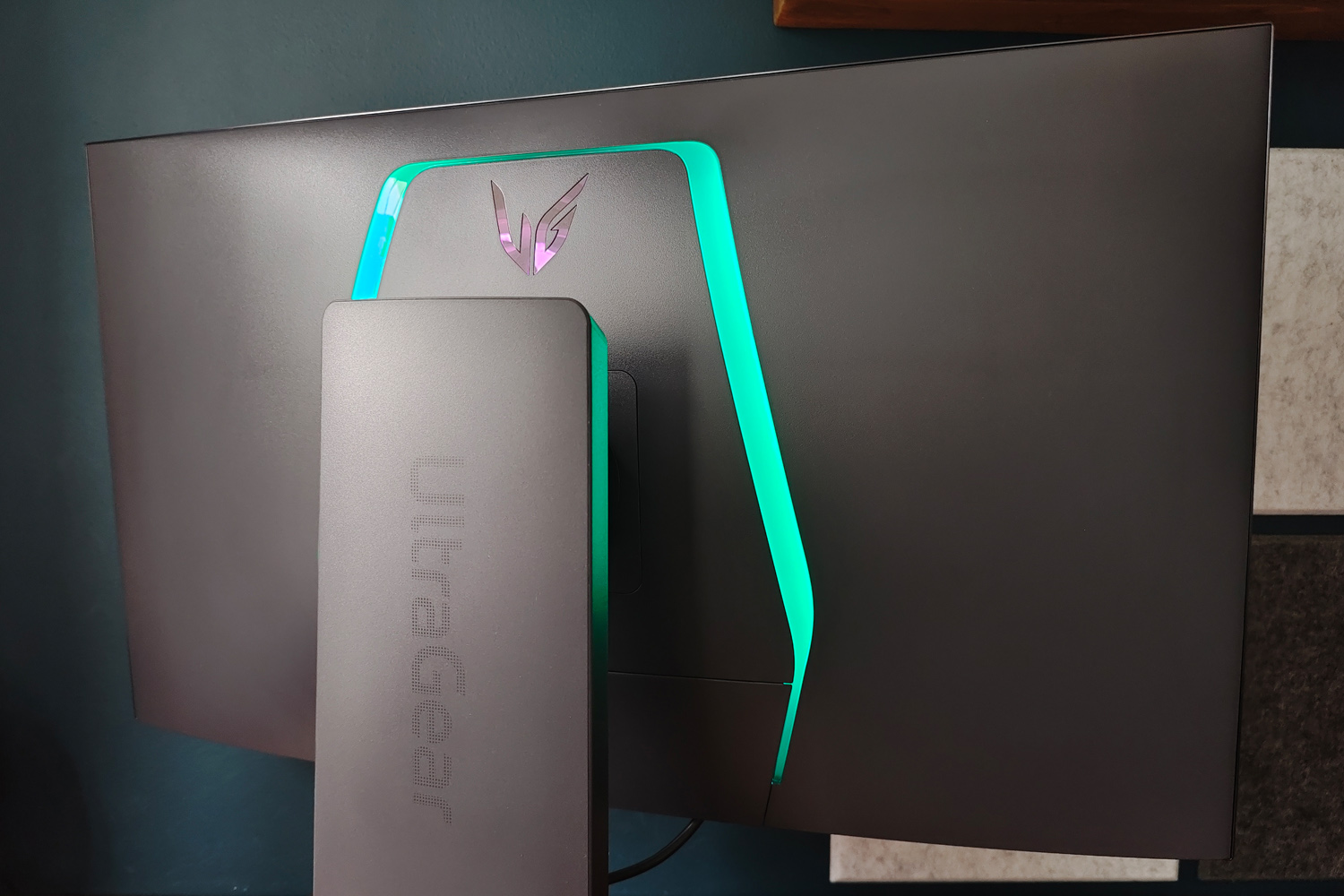
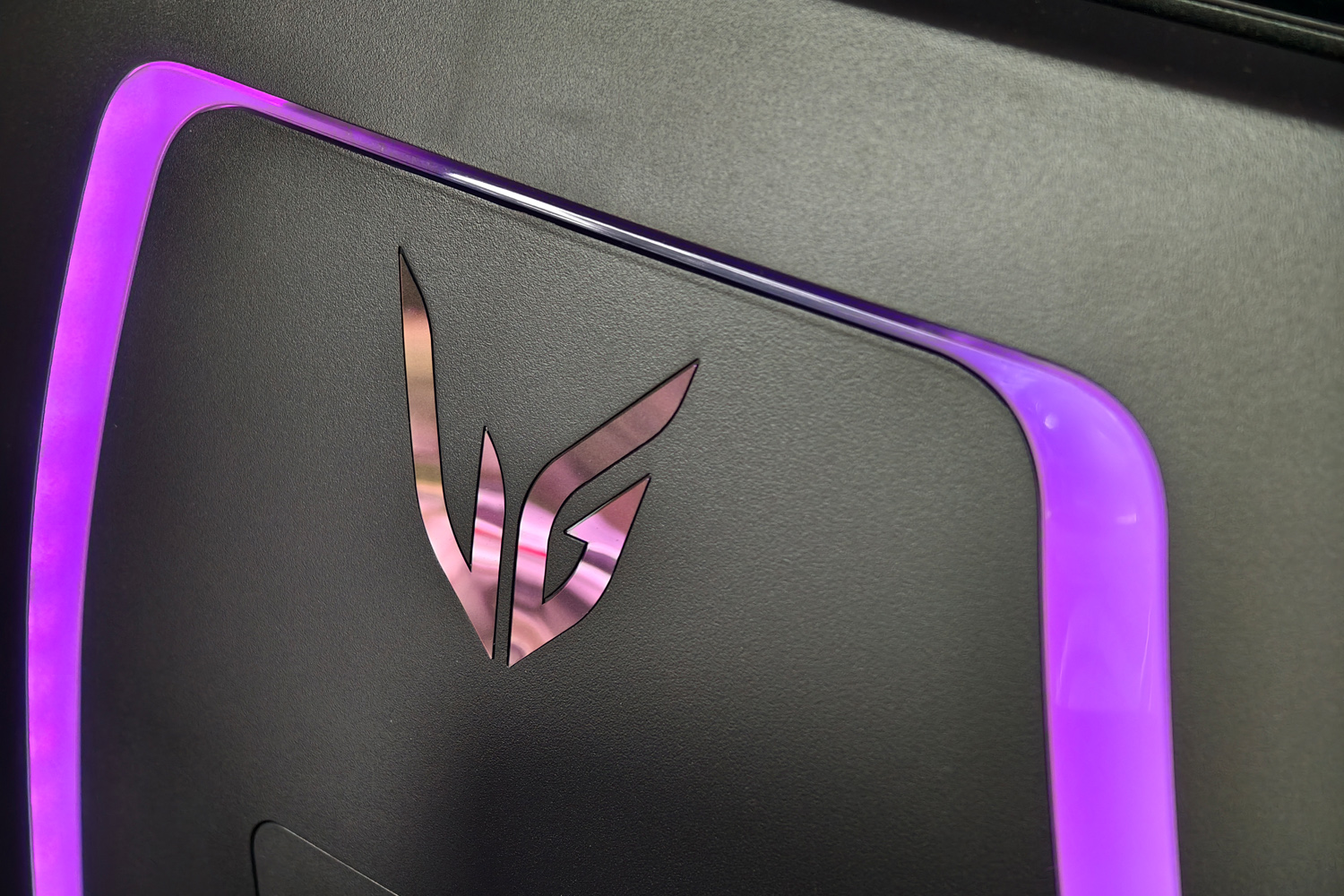
The 32GS95UE is a sharp-looking screen from pretty much every angle. LG hasn’t embraced the usual OTT gamer aesthetic, going instead for a minimal design that I think has much wider appeal. A pair of subdued ambient lighting strips on the back of the monitor are the only obvious nod to gaming. Branding has been pared back to the tiniest of logos on the hexagonal stand foot and an Ultragear emblem at the rear.
This isn’t the slimmest OLED screen around, and I’ve seen ones with skinnier bezels, but there’s not a lot in it. The stand is pretty traditional, but it’s also super adjustable, with plenty of height, tilt and swivel. A useful cable tidy hole in the central part keeps wires neatly out of sight for anything other than the tallest position. The stand also caters to fans of portrait oriented monitors, with a full 90-degree rotation. Or you can whip the stand off entirely; the panel is VESA-ready for wall-mounting or attaching to a monitor arm.
There’s an active cooling fan inside the monitor to stop the panel from getting too toasty, but I had to put my ear to the case to hear it. My work laptop was louder from a normal sitting distance, so there’s no chance of it being perceptible if you have a gaming desktop nearby.
My only real issue is that the whole thing is made from plastic, which doesn’t feel in step with the asking price. Samsung’s updated Odyssey G8 has a metal frame that’s a lot more premium. The slight purple/blue tone didn’t match the rest of my gaming setup, either; if you’re a stickler for symmetry that might irk a bit. That said, creaks and flexing are at an absolute minimum here.
Features & connectivity: how refreshing
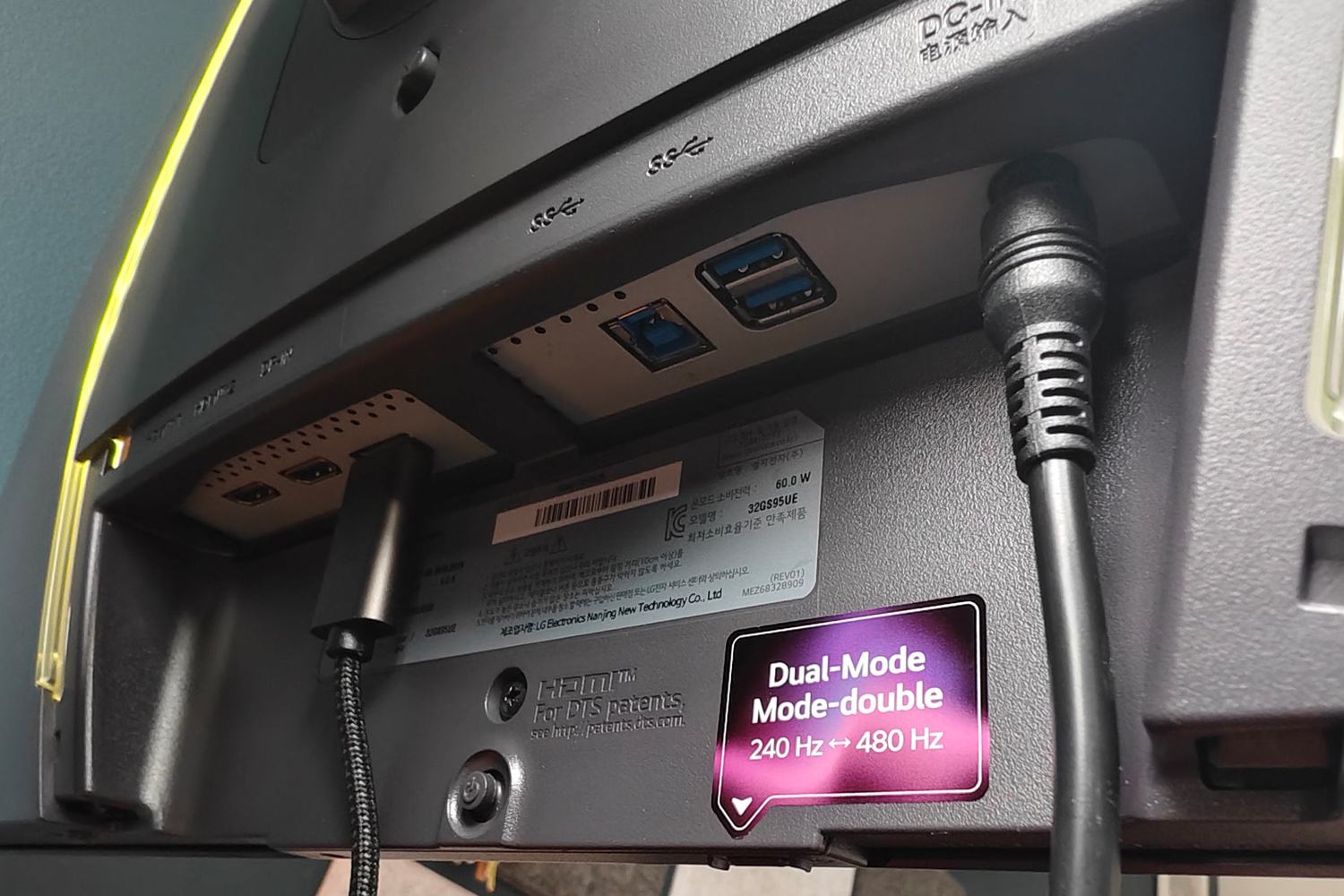
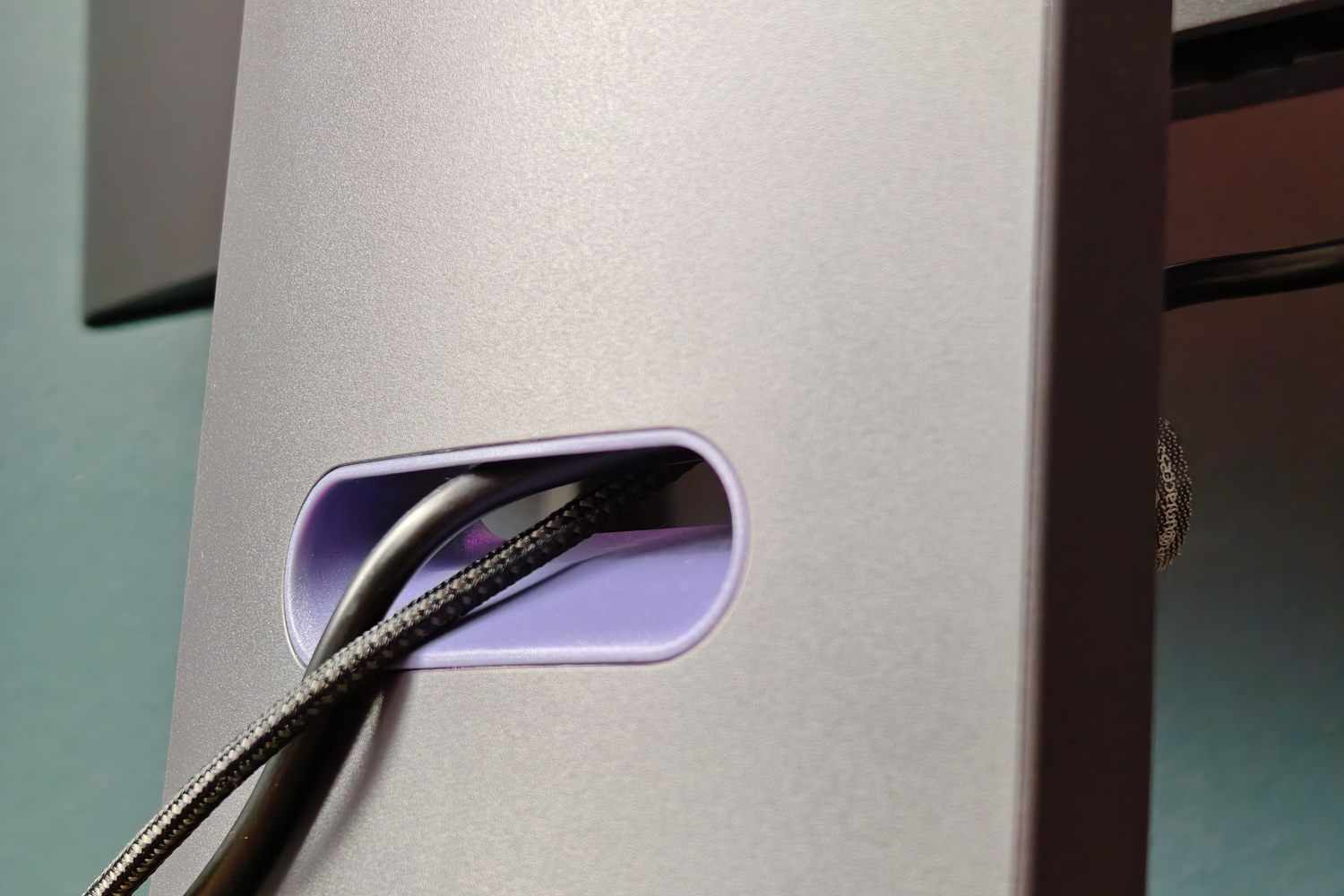
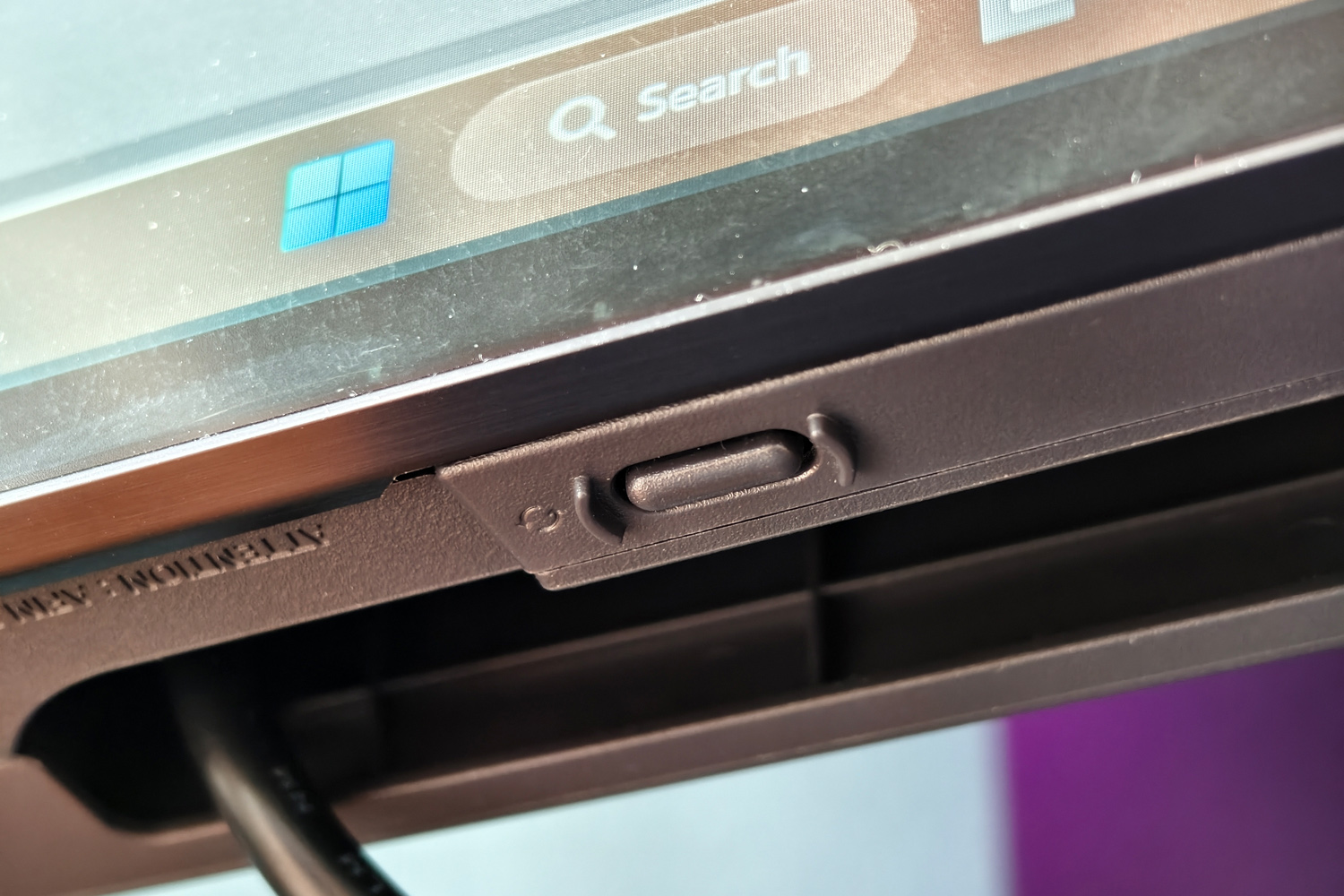
Unclipping a small plastic cover reveals a decent selection of ports at the rear of the LG 32GS95UE, including two HDMI 2.1 connections and a single, full-size DisplayPort 1.4. The former support variable refresh rate (VRR) for console gamers, along with 4K HDR at 120Hz. Dolby Vision doesn’t make the cut, though. I like that LG has built the 3.5mm headphone port into the outer frame, where it’s much easier to reach. It can manage DTS and DTS:X audio passthrough if your headphones support the tech.
There’s one upstream USB and two USB-A ports for freeing up things like accessory dongles from your PC. It’s a shame there’s no USB type-C connection here, as they’re a great way to cut down on cable clutter when hooking up a laptop – especially when they support USB power delivery.
I was really impressed by the built-in speakers, which really pack a punch. Two 10W full-range actuators vibrate the panel to produce sound that’s clear and loud enough for pretty much anything other than competitive gaming. OK, so there’s not much in the way of bass, but I never felt I had to use headphones for watching videos or having background music on while I was working.
What you don’t get here is any kind of smart TV or gaming hub. Samsung’s Odyssey G8 also ships with a remote control, which makes it a better bet for uni dorms and studio apartments that only have room for one smaller screen.
Instead, LG is all-in on gaming, thanks to a dual mode panel that lets you exchange resolution for refresh rate in competitive games. I saw similar tech on the Razer Blade 16 gaming laptop late last year, but this is the first time I’ve tried it on a monitor. 4K resolution at 240Hz is perfect for single-player titles, and not the least bit lax for most multiplayer ones, but esports pros can double up to a rapid 480Hz if they drop to 1080p. It’s a one button switch, too, with no need to dive into menus or change graphics settings in-game.
Stretched over the full 32in, image quality definitely takes a hit, but as long as you’re not sat with your nose against the glass, it’s not a dealbreaker. Letterbox modes that mimic the 24in and 27in monitor sizes preferred by esports pros are worse still, and are really only must-haves for anyone drawing a salary from playing games.
I’m no competitive gamer, but could definitely feel the difference when making rapid mouse movements in shooters like Valorant and Counter Strike 2 at 480Hz. It didn’t improve my performance to any noticeable degree, though, and 240Hz still feels gloriously responsive if you’re used to a slower refresh rate screen.
Interface: stick it to me
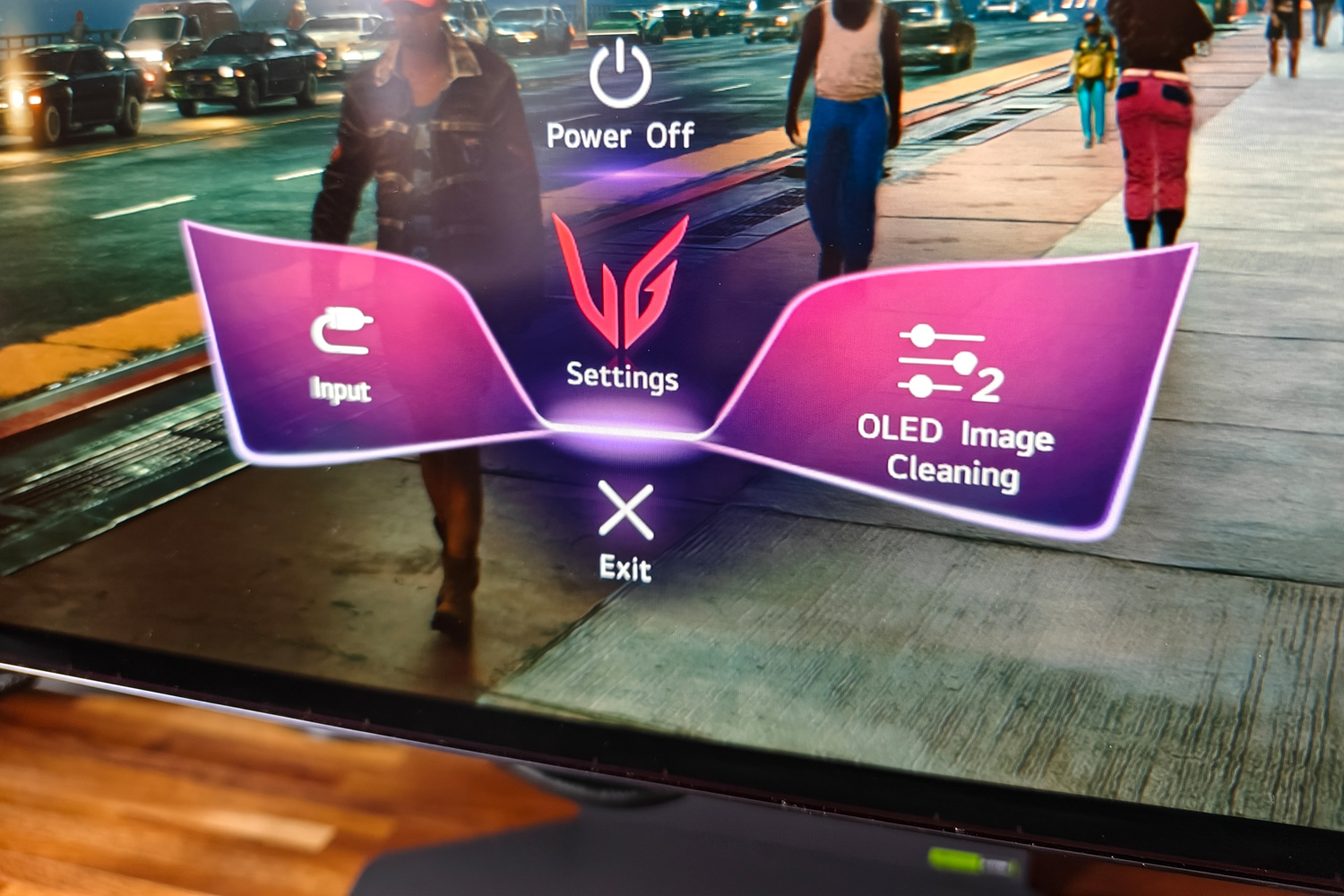
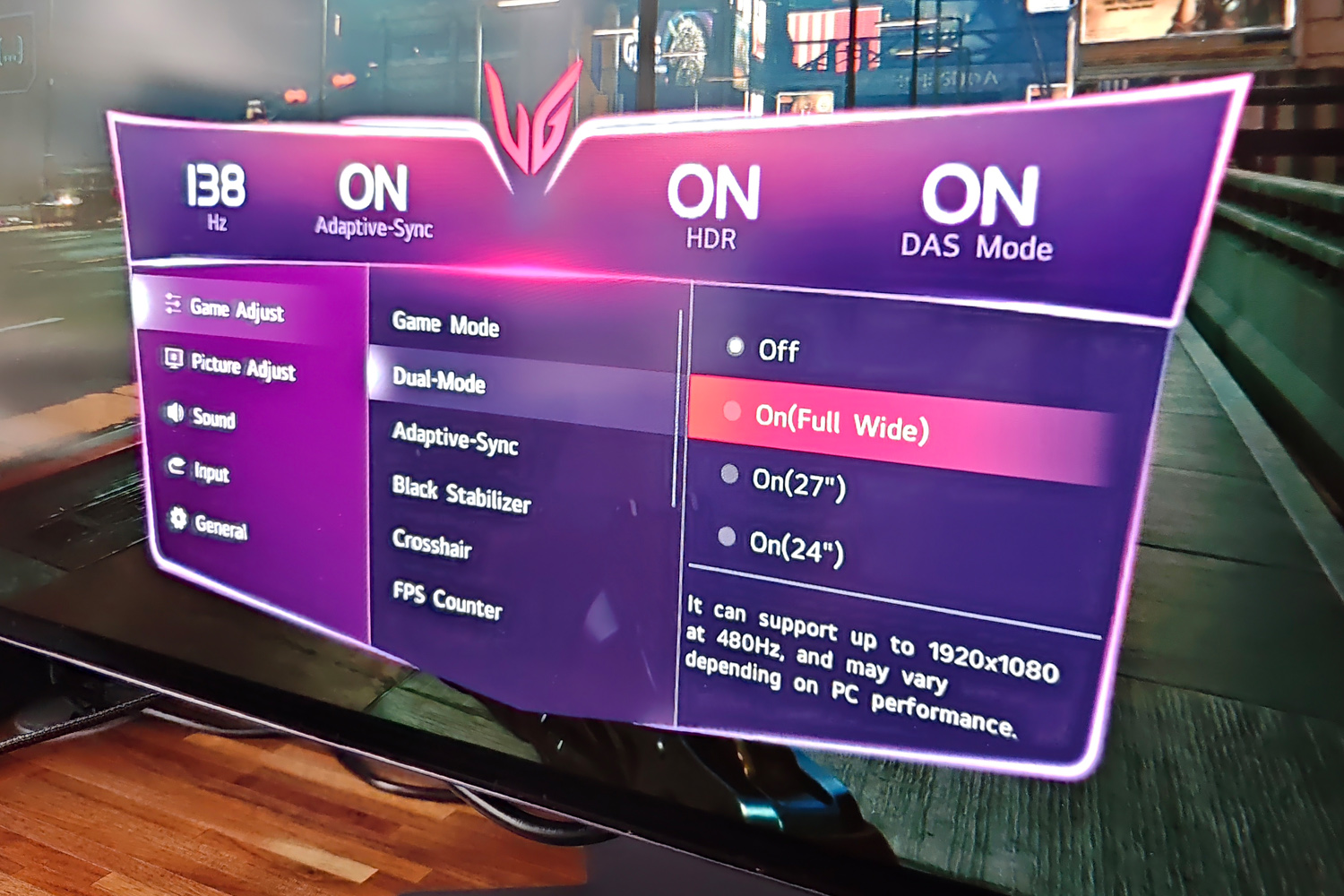
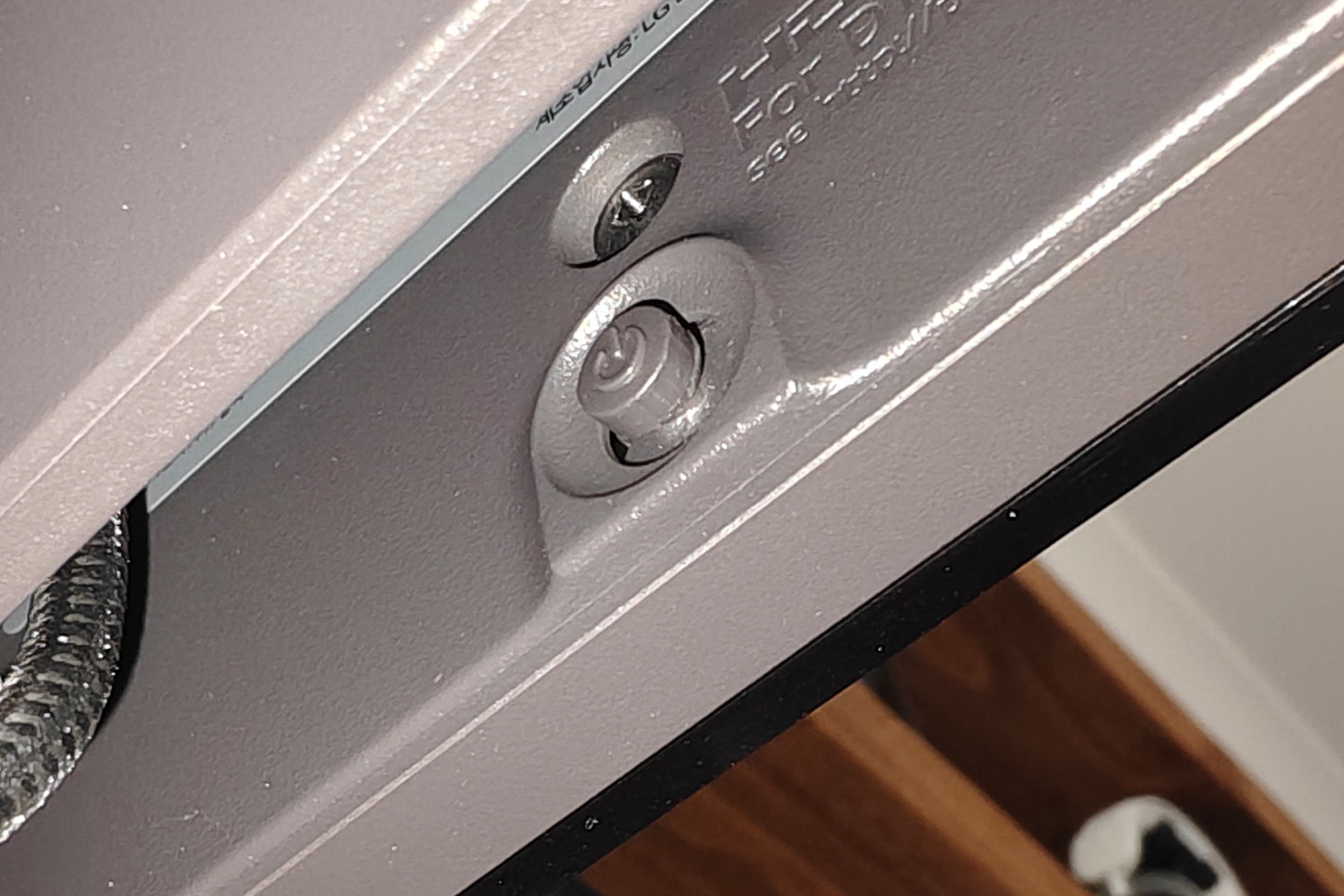
LG hasn’t broken the mould for the 32GS95UE’s on-screen display: its joystick controller, hidden at the centre-bottom of the monitor’s rear, makes scrolling through menus and making selections a breeze. The only other button is dedicated to the 480Hz dual mode, and can’t be changed.
The interface is similar to previous UltraGear screens, taking up a small portion of the screen so you can see any adjustments take effect in real-time. It covers all the picture quality basics, including six-way RGB adjustment and a manual colour temperature slider. There’s also a few ways to tweak the ambient lights on the back of the panel. You can set specific colours or choose colour cycling, but can’t set how quickly it changes, or adjust the brightness.
Don’t ignore the selection of OLED care settings if you’ll be spending a lot of time with static elements onscreen; refreshing the pixels should prevent (or at least dramatically reduce) panel burn-in over time. You get a two-year warranty with the 32GS95UE, which is a little less than what some rivals are offering.
There are a couple of gamer-specific additions, including a virtual crosshair and frame rate counter. A black level optimiser is handy, too – I could bump it up for dingy sci-fi The Callisto Protocol, then dial it back for the much brighter Hi-Fi Rush.
I like that LG’s OnScreen Control PC software can adjust a few settings from the Windows desktop, but you’ll still need to head to the OSD for the more advanced stuff. It handles firmware updates, though, so is still worth a download.
Picture quality: woah-LED
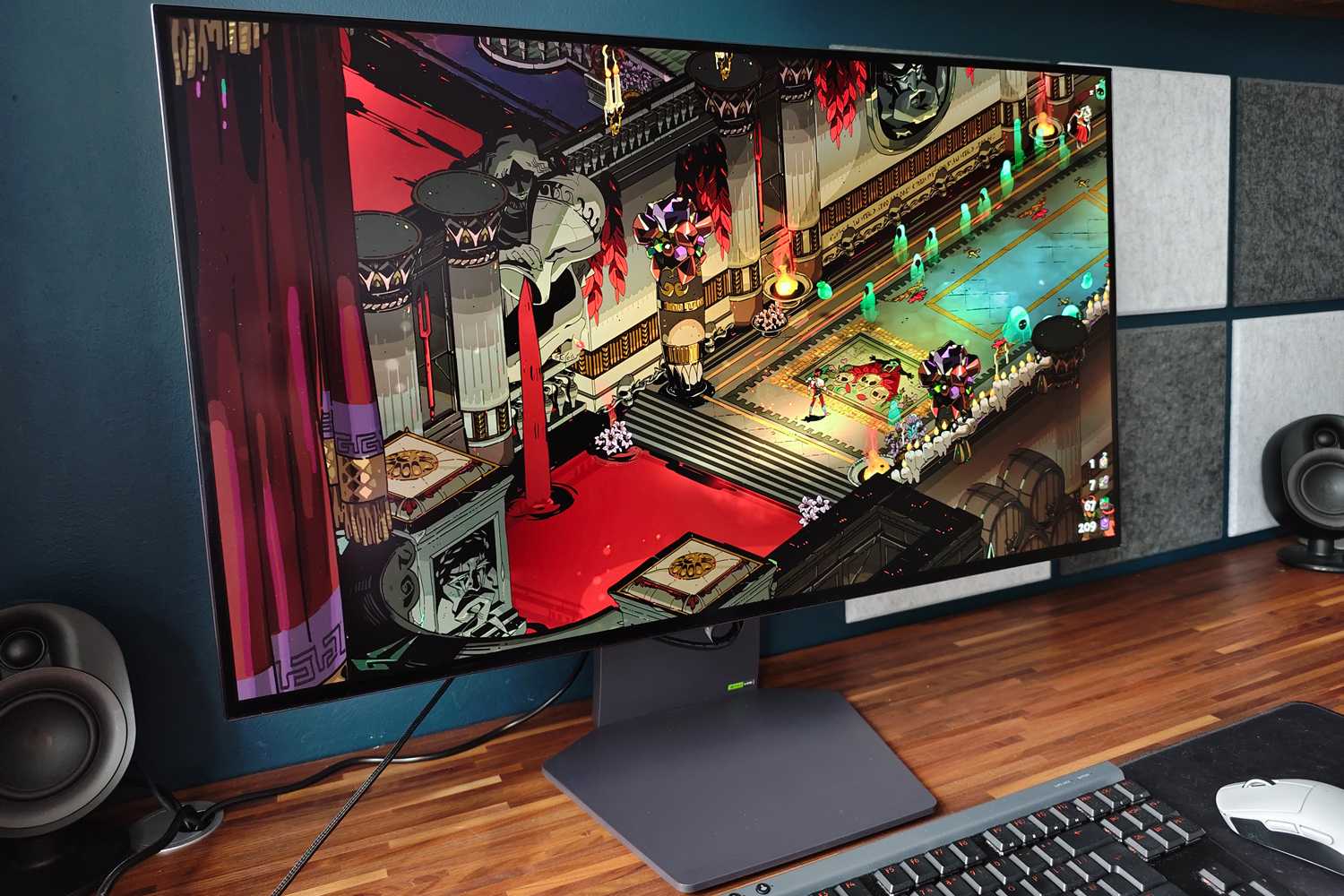
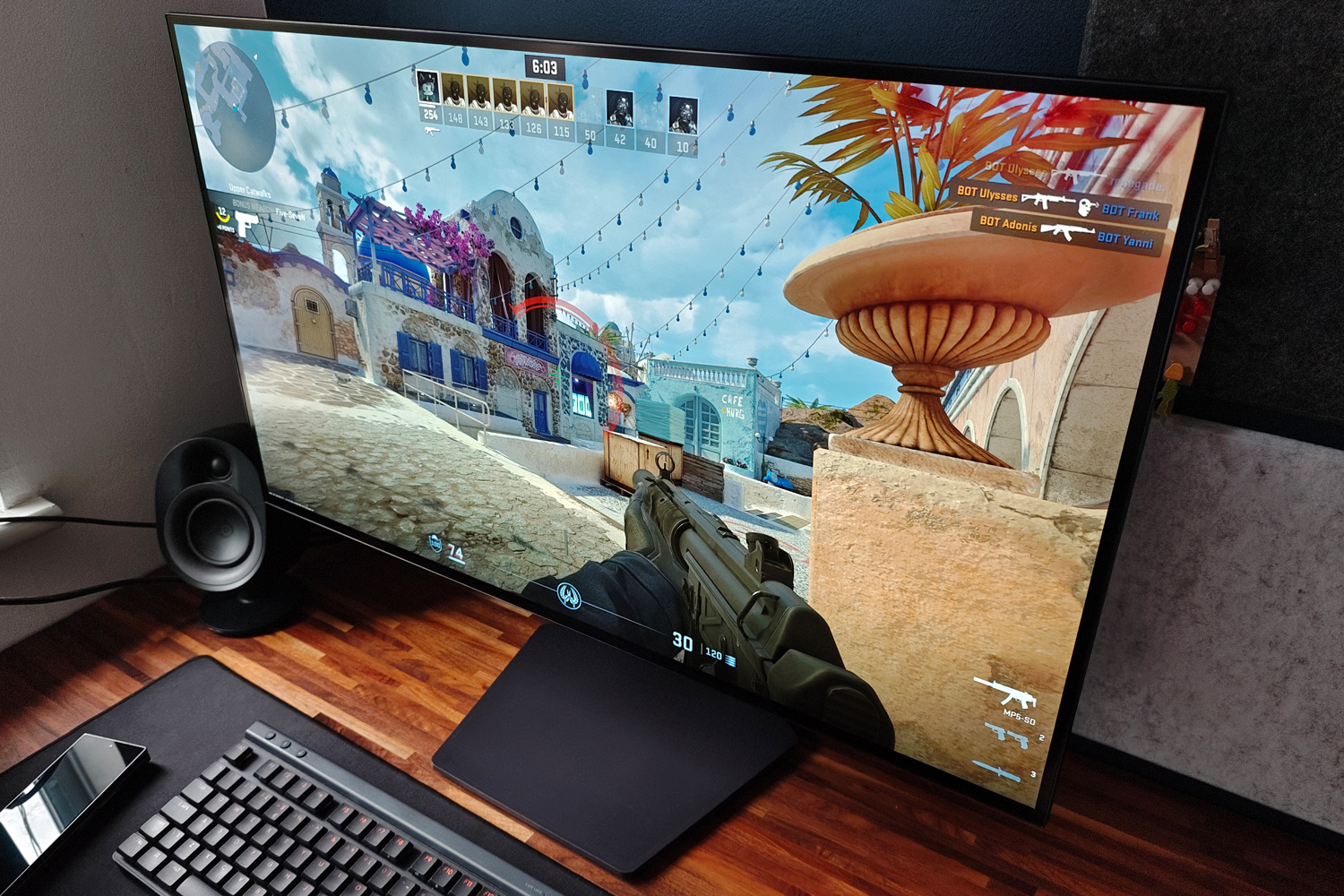
Gaming on any OLED is a transformative experience, with a near-infinite contrast ratio and the deepest blacks this side of the Mariana Trench. The LG 32GS95UE doesn’t disappoint on either front, and its 4K native resolution looks brilliantly crisp from just about any distance. The underlying WOLED panel now uses a red-green-white-blue sub-pixel layout, which makes text look that little bit sharper than it did on 1440p screens using a slightly different arrangement. It’ll also consume as much as 40% less power than a QD-OLED when showing mostly-white content – something to think about if you’re paying the electricity bill.
Viewing angles are impeccable, and with no need for a backlight there’s zero chance of blooming or halo effects around bright objects, even against perfectly black backgrounds. The matte panel coating isn’t remotely grainy, and did a fantastic job at diffusing light reflections. My desk is directly next to a window, so I have to pull the blinds down when gaming on glossy monitors; that wasn’t an issue here. Blacks also looked deeper than they did on a QD-OLED display when playing in well-lit conditions.
Input lag is about as low as it gets, at less than 0.35ms. The only monitors that give the 32GS95UE a run for its money are other gaming OLEDs, so competitive gamers have nothing to worry about. Pixel response times are pretty much instant, too.
Out of the box, the 32GS95UE’s ‘Gamer 1’ picture preset delivers wonderfully vibrant colours that lean a little warm using the standard 2.2 gamma curve. It covers a very good 98.5% of the P3 colour space, and has the visual oomph I expect from OLED. It’s a great choice for just about every game genre, though there’s room for improvement if you’re doing any colour-sensitive work. Unfortunately it takes more effort than switching to the sRGB mode, which has a humdrum colour deltaE of over 5; a hardware calibration tool can cut that in half.
Clarity of motion is absolutely phenomenal, provided your graphics card can supply enough frames to make the most of the 32GS95UE’s refresh rate. In the 4K/240Hz mode, movement looks as clean as other 240Hz OLEDs I’ve tried; the nature of the tech means visuals are on par with 360Hz LCD screens, too. Motion is even better controlled when switching to Full HD/480Hz, with a cleaner image than the absolute fastest TN panel LCD monitors. That you can get this without being forced to switch off things like HDR or variable refresh gives it a clear edge over the LCD competition in my book.
What this monitor won’t do is blow you away with its brightness. In SDR mode, things are capped to around 260 nits, which is on par with other OLED monitors Stuff has reviewed. That’s half what you’ll get from the brightest LCD gaming monitors. Things definitely improve with HDR content, which is configured for the DisplayHDR 400 True Black standard, but remain a step behind the LCD competition. QD-OLEDs also have an advantage when it comes to colour luminance – or how bright colours are perceived – because of how this panel uses its white sub-pixels. A peak 800nits still looked plenty bright to me while gaming in a dark room, mind.
LG UltraGear 32GS95UE verdict
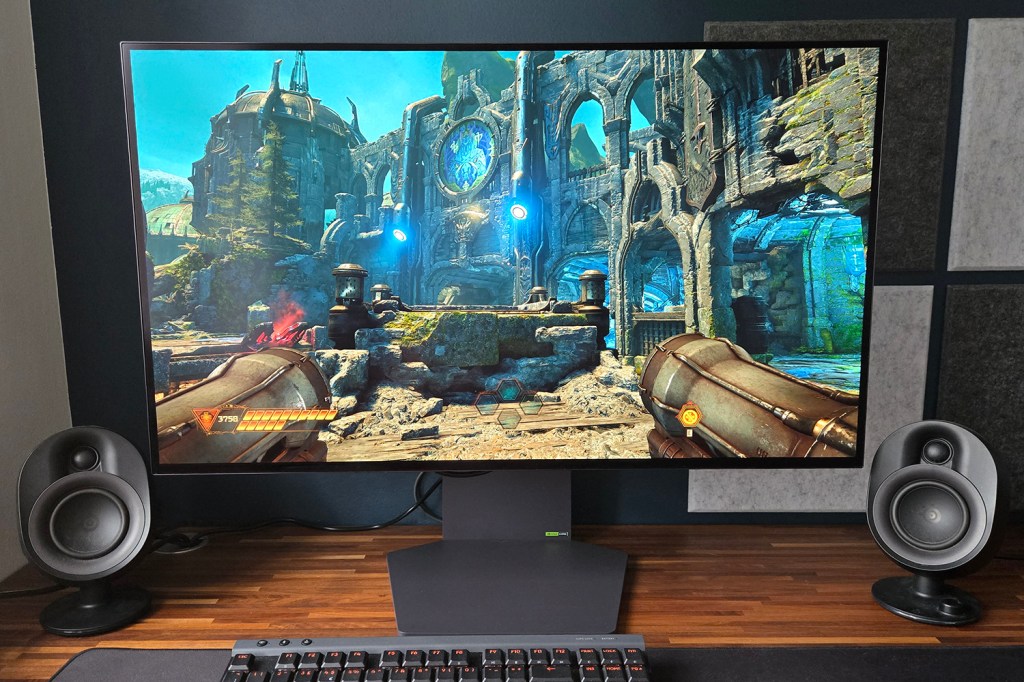
With outstanding visuals, near-instant response times and impressively impactful audio, the 32GS95UE is a fantastic monitor that should be near the top of any serious gamer’s shopping list. The 480Hz dual mode gives a competitive edge you won’t find on rival 4K OLEDs, at least for the time being. Anyone who has to game near a window will love the matte finish, which helps cut down on glare, and while connectivity could be better, it has all the essentials.
Colour accuracy isn’t top of the class, and this isn’t the brightest OLED around – though those are only issues if you’re after an all-rounder for creative tasks. Launch pricing is also pretty spicy, with the QD-OLED competition being slightly easier on the wallet. If you can live with 240Hz, a Samsung Odyssey G8 makes a lot of sense – but for esports addicts, the LG is absolutely worth the premium.
Stuff Says…
Pro-grade refresh rates and response times meet an impactful OLED picture. The LG UltraGear 32GS95UE is a fantastic – if expensive – gaming monitor that doesn’t need gimmicks to impress.
Pros
Gorgeous 4K display with epic contrast
Dual mode resolution/refresh rate great for gamers
Impressive onboard audio
Cons
Not the last word in colour accuracy or brightness
Connectivity a bit limited versus rivals
The competition is slightly cheaper
LG UltraGear 32GS95UE technical specifications
| Screen size | 31.46in, 16:9 |
| Resolution | 3840×2160 |
| Refresh rate | 240Hz (4K) 480Hz (Full HD), FreeSync/G-Sync/VRR |
| Response time | 0.03ms |
| Brightness | 275 nits (SDR) / 1300 nits (HDR) |
| HDR | DisplayHDR True Black 400 |
| Connectivity | 2x HDMI 2.1, 1x DisplayPort 1.4, 2x USB-A 3.1, 1x USB-B 3.1 |
| Dimensions | 713x627x279mm, 8.98kg (with stand) 713x411x66mm, 5.57kg (panel only) |


